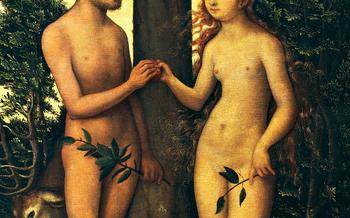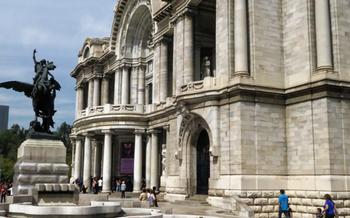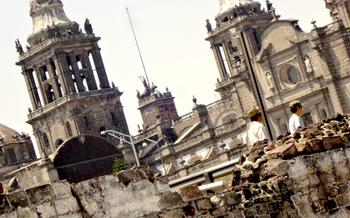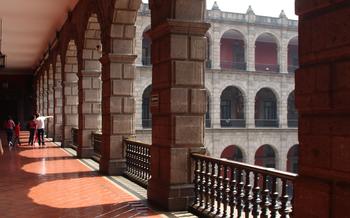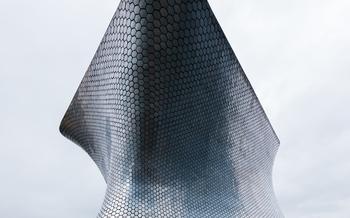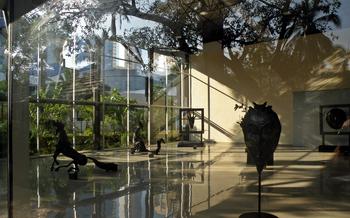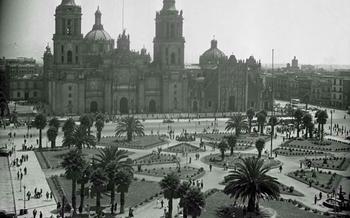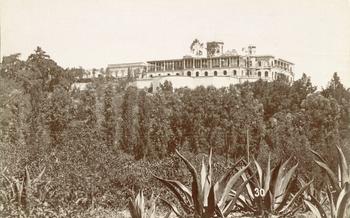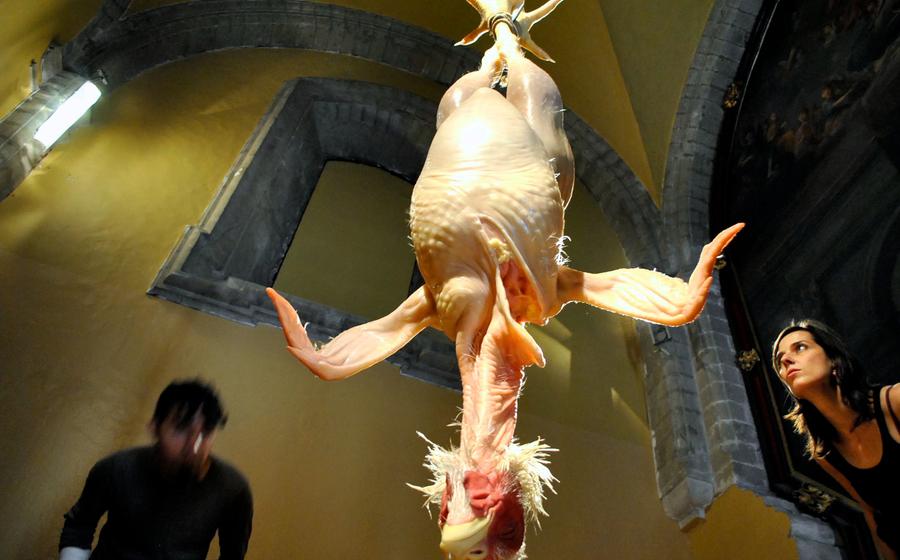
Antiguo Colegio de San Ildefonso
- Architectural styles and influences:
- Murals and Artwork:
- Permanent Exhibitions:
- Temporary Exhibitions:
- Guided Tours
- Architecture and Design:
- Cultural Events:
- Cafeteria and Gift Shop
- Accessibility:
- Location and Transportation:
- Photography and Videography:
- Educational Programs
- Insider Tip:
Architectural styles and influences:
The Antiguo Colegio de San Ildefonso stands as a testament to the architectural evolution of Mexico City. Its construction began in 1588, blending Renaissance, Gothic, and Baroque influences into a cohesive masterpiece. The main facade showcases intricate Plateresque ornamentation, characterized by delicate carvings and decorative elements. The interior courtyard, known as the Patio de los Naranjos, exudes a sense of tranquility with its central fountain and orange trees, reflecting the influence of Andalusian architecture. Over the centuries, the building underwent various renovations and additions, resulting in a harmonious fusion of architectural styles that narrates the rich history of Mexico's capital.
Murals and Artwork:
The Antiguo Colegio de San Ildefonso is renowned for its stunning murals, which are widely considered masterpieces of the Mexican muralist movement. This artistic movement emerged in the early 20th century as a means of expressing social and political messages through large-scale public artworks. Some of the most famous muralists who created works at San Ildefonso include Diego Rivera, José Clemente Orozco, and David Alfaro Siqueiros.
These murals are not just visually striking but also carry profound symbolic and historical significance. They depict scenes from Mexican history, mythology, and everyday life, often with a focus on social justice and the struggles of the working class. The artists used various techniques and styles, including fresco, oil, and tempera, to create these powerful and evocative works of art.
One of the most iconic murals at San Ildefonso is Rivera's "Creation," which depicts the origins of the universe and the birth of humanity. Orozco's "The Trench" portrays the horrors of war and the suffering of the Mexican people during the Revolution. Siqueiros's "The Elements" explores the relationship between humans and the natural world.
These murals have played a crucial role in shaping Mexico's national identity and continue to inspire and educate visitors from around the world. They offer a unique and immersive experience that allows visitors to connect with Mexico's rich cultural heritage and gain a deeper understanding of its history and struggles.
Permanent Exhibitions:
The Antiguo Colegio de San Ildefonso houses a diverse collection of permanent exhibitions that showcase the rich history and cultural heritage of Mexico. The museum's permanent galleries are divided into thematic sections, each focusing on a specific aspect of Mexican art and culture. Highlights include the "History of Mexico" gallery, which presents a chronological journey through Mexico's past from pre-Columbian civilizations to the present day. The "Art and Identity" gallery explores the diverse artistic expressions that have shaped Mexican identity, from traditional crafts and folk art to contemporary installations. Visitors can also admire a collection of Mexican muralism, with works by renowned artists such as Diego Rivera, José Clemente Orozco, and David Alfaro Siqueiros. These stunning murals depict iconic scenes from Mexican history and culture, and offer a powerful commentary on social and political issues. The museum also features a collection of pre-Hispanic artifacts, including sculptures, ceramics, and jewelry, providing a glimpse into the rich cultural heritage of Mexico's ancient civilizations.
Temporary Exhibitions:
The Antiguo Colegio de San Ildefonso also hosts a diverse array of temporary exhibitions throughout the year. These exhibitions showcase the works of both established and emerging artists, as well as explore a wide range of themes and artistic movements. Past exhibitions have featured the works of renowned artists such as Frida Kahlo, Diego Rivera, and José Clemente Orozco, as well as contemporary artists from Mexico and around the world. Curatorial themes have ranged from historical retrospectives to contemporary social and political issues.
In addition to the main exhibitions, the museum also hosts special events and workshops associated with the exhibitions. These events may include artist talks, panel discussions, and hands-on workshops, providing visitors with an opportunity to engage with the artwork and the artists themselves. Some exhibitions may require advance planning or reservations, so be sure to check the museum's website or social media pages for more information.
Guided Tours
Guided tours are available in English and Spanish to enhance your visit to the Antiguo Colegio de San Ildefonso. These tours provide an in-depth exploration of the museum's history, architecture, and artistic treasures. Knowledgeable guides will lead you through the halls, sharing insider insights and historical anecdotes that bring the museum's stories to life.
The tours typically cover the highlights of the permanent collection, including the iconic murals and other significant artworks. You'll learn about the techniques and styles used by the artists and the symbolism and messages conveyed through their work. The guides will also point out architectural details and design elements that contribute to the unique character of the building.
Guided tours are an excellent way to gain a deeper understanding of the Antiguo Colegio de San Ildefonso and its cultural significance. Reservations are recommended, especially for groups, and can be made through the museum's website or by contacting the information desk. The cost of a guided tour is nominal and varies depending on the size of your group.
Architecture and Design:
The Antiguo Colegio de San Ildefonso stands as a testament to the architectural evolution of Mexico City. Its original construction in the 16th century showcased the influence of Spanish colonial architecture, featuring a simple yet elegant design. Over the centuries, the building has undergone several renovations and restorations, each leaving its mark on the overall appearance. Notable additions include the Churrigueresque façade, characterized by intricate carvings and ornamental details, and the neoclassical elements incorporated during the 19th century. Today, the building seamlessly blends its historic grandeur with contemporary interventions, such as the glass-enclosed courtyard that serves as the main entrance. The result is a harmonious fusion of architectural styles that represents the rich cultural heritage of Mexico.
Cultural Events:
The Antiguo Colegio de San Ildef hosts a variety of events throughout the year. Music concerts, dance performances, and theater productions take place within the historic walls, creating an immersive and unforgettable experience for visitors.
Art enthusiasts can attend workshops, lectures, and film screenings that delve deeper into the world of Mexican art and culture. These events provide a platform for local artists to showcase their work and engage with the community. During festivals and holidays, the museum comes alive with special events, exhibitions, and traditional performances that celebrate Mexico's rich heritage.
Cafeteria and Gift Shop
The Antiguo Colegio de San Ildefonso houses a small cafeteria that offers a variety of light meals, snacks, and beverages. The menu features a mix of traditional Mexican dishes and international favorites, all prepared with fresh ingredients. Prices are reasonable, and the cafeteria provides a convenient option for visitors who want to grab a quick bite to eat without leaving the museum.
The museum also has a gift shop that sells a wide range of souvenirs and merchandise related to its collections and exhibitions. Visitors can find books, postcards, posters, replicas of pre-Columbian artifacts, and other unique items. The gift shop supports local artists and artisans, and all proceeds help to fund the museum's educational programs and conservation efforts.
Accessibility:
The Antiguo Colegio de San Ildefonso is committed to providing an inclusive and accessible experience for visitors with disabilities. To this end, the museum features a range of accessibility features, ensuring that everyone can enjoy and engage with its cultural offerings.
Wheelchair ramps and elevators are strategically placed throughout the museum, facilitating easy movement between different levels and exhibition spaces. Accessible restrooms are also available, ensuring comfort and convenience for visitors with special needs.
For visitors with visual or hearing impairments, the museum provides assistive devices and tools to enhance their experience. Braille signage and audio guides are available to assist visually impaired visitors in navigating the museum and learning about the exhibits. For those with hearing impairments, sign language interpretation can be arranged upon request, ensuring equal access to the museum's educational and cultural programs.
On the museum's website, comprehensive accessibility information is provided, including details on accessible entrances, elevator locations, and available assistive devices. This information empowers visitors with disabilities to plan their visit seamlessly and make the most of their time at the Antiguo Colegio de San Ildefonso.
The museum's commitment to accessibility extends beyond physical accommodations. Staff members are trained to be welcoming and supportive, providing assistance and guidance to visitors with disabilities whenever needed. This inclusive approach ensures that everyone feels welcome and respected, fostering a truly inclusive environment where all visitors can engage with and appreciate the museum's rich cultural heritage.
Location and Transportation:
The Antiguo Colegio de San Ildefonso is strategically located in the heart of Mexico City's historic center, at Justo Alternatively, numerous bus routes stop within walking distance of the museum, providing convenient connections from various parts of the city.
For those arriving by car, limited street parking is available in the surrounding area. However, due to the high demand and traffic congestion in the historic center, it's advisable to use public transportation or consider nearby parking garages.
Photography and Videography:
Photography and videography are generally permitted within the Antiguo Colegio de San Ildefonso, allowing visitors to capture and share their experiences. However, certain guidelines must be followed to ensure the preservation of the artwork and the enjoyment of all visitors.
Using flash or tripods is prohibited, as these can damage the delicate paintings and murals. Commercial photography or filming, for promotional or commercial purposes, requires a special permit from the museum administration.
Sharing photos and videos on social media is encouraged, as this helps spread awareness about the museum and its collections. However, it is important to tag the museum and give proper credit to the artists.
By respecting these guidelines, visitors can contribute to the preservation of this historic institution and share their experiences with others.
Educational Programs
The Antiguo Colegio de San Ildefonso offers a diverse range of educational programs that cater to various age groups and interests. These programs aim to promote art appreciation, history, and cultural understanding among the community.
Workshops and Courses: The museum organizes workshops and courses that delve deeper into specific art techniques, art history, and conservation practices. These programs are led by experienced artists, historians, and conservators, providing participants with hands-on experience and in-depth knowledge.
Art Classes: Aspiring artists can enroll in art classes that cover a variety of mediums, including painting, drawing, sculpture, and printmaking. These classes offer a supportive environment for students to develop their artistic skills and explore their creativity.
History Lectures: The museum hosts lectures and talks by renowned historians and experts, shedding light on the history of Mexico, the muralist movement, and the significance of the Antiguo Colegio de San Ildefonso. These lectures provide valuable insights into the cultural and historical context of the museum's collections.
Summer Camps and After-School Programs: During school breaks, the museum offers summer camps and after-school programs tailored for children and teens. These programs combine art activities, history lessons, and interactive games, making learning fun and engaging for young minds.
Opportunities for Students and Researchers: The museum collaborates with educational institutions to offer internships, research opportunities, and scholarships for students and researchers. These programs provide students with practical experience in museum studies, art conservation, and curatorial work, preparing them for careers in the cultural sector.
Insider Tip:
-
Hidden Gems: Explore the hidden courtyard, the Patio de los Pasos Perdidos, with its serene atmosphere and beautiful fountain. Don't miss the impressive staircase, the Escalera de los Sapos, adorned with intricate carvings.
-
Best Time to Visit: To savor a tranquil experience, aim to visit during weekdays or early mornings on weekends. This will allow you to fully appreciate the artwork and architecture without the hustle and bustle of large crowds.
-
Local Delights: After immersing yourself in the cultural treasures of San Ildefonso, head to nearby Café La Ópera for a delicious and authentic Mexican meal. Indulge in traditional dishes like enchiladas, pozole, or tacos, accompanied by refreshing beverages.
-
Photo Opportunities: Capture stunning shots of the courtyard's arches and columns, creating a picturesque frame for your memories. For a unique perspective, head to the rooftop terrace, which offers panoramic views of the historic center of Mexico City.
